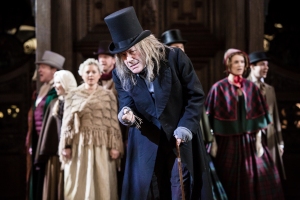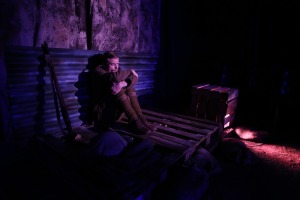After being sufficiently upset by Akty immediately before, I wasn’t quite sure I was up for a “tragedy”. What’s more, I wasn’t sure I was up for a biblical one. Tragedia Jana, translating as “The Tragedy of John”, is the tale of John the Baptist. But, if anyone was going to do something better than just a so-so Salome, it would be Chorea and Warsaw Scenic Society.

Scene from ‘Tragedia Jana’. Photograph: courtesy of Rami Shaya.
Tekst / Writing
Although taking its narrative from the bible, Chorea, working with Warsaw Scenic Society, stage what is actually a very old Polish play; Jakub Gawatobic’s 1619, “Tragedy or Images of the Death of Saint John the Baptist God’s Messenger” (I’m not even going to attempt typing or pronouncing the original Polish).
But how do you make a work that’s half a millennium old interesting, modern, and exciting?
Well, it’s all down to this theatrical partnership’s brilliant work with direction and physical theatre.
Tragedia Jana is a superlative example of how to make an ancient text resonate as if it were a modern one. Director Waldemar Raźniak, working closely alongside choreographer Liwia Bargieł, give the play a striking sense of daring chic and divine spark.
Where the text clunks and stumbles with its antiquated metre and obtuse disappeared dialects, Raźniak and Bargieł’s use physical theatre to makes Tragedia Jana’s 75-minute run-time feel like 7 seconds in heaven.
It’s the physical theatre that keeps the pace going, pushing the age and awkwardness of the text itself into the wings, giving visual strong visual storytelling the central spotlight. This makes sure that the performance and experience of watching Tragedia Jana is lively and limber rather than dull and doddering.

Scene from ‘Tragedia Jana’. Photograph: courtesy of Rami Shaya.
Reżyseria / Direction
As for how Raźniak approaches the text, there are some wonderful subversions on the theme of faith. One example is Gawatobic’s demons, who goad and usher John on to his fate, being depicted here as Suffi dancers. It turns holy and sacred into profane, including setting the stage for some really arresting moments. Specifically, the intoxicating spinning they do at sheer crescendos in the play’s narrative.
There’s also a general feel that John’s demise was far from a divine revelation, touching on issues such as fundamentalism and how piety does not always contribute to the greater good.
Elsewhere, Raźniak and Bargieł take plenty of opportunities to create some spellbinding moments. The baptism scene involves the company spitting water over John. It’s quite an image to see Tomasz Rodowicz crouched down on the floor with a dozen people circling and spraying him with liquid and spit that they discharge high into the air, sparking in the spotlighting.
One particular pinnacle of the show for me was Salome’s dance in an attempt to seduce John. After the frenzied erotic movements erupting and fidgeting all around the performance area directly before it, Salome takes centre stage, downlit and dancing hypnotically along to Tomasz Krzyżanowski astonishing religious white noise. It completely consumes your attention.
As Salome’s gyrating reaches an arousing climax, John stumbles towards her, covers her barely clothed body in his shawl, and collapses at her feet.
I have very rarely been so hooked in a moment that it left my mouth so agape and feeling utterly astounded. Yet, Raźniak and Bargieł better even this incredible moment with an absolutely knockout finale.

Scene from ‘Tragedia Jana’. Photograph: Courtesy of Rami Shaya.
Producja / Production
While I have already mentioned Krzyżanowski treatment of Salome’s dance scene, it must be mentioned that the rest of his music and sound design is as equally as spellbinding. Most notably, the use of stereo, placing sound and music both in front, behind, and to the sides of you, is so amazingly disorientating that “immersive” doesn’t even start to cover it.
Lighting is also crucial to the show. Moments when shafts of light, spot, or downlighting are played around with, especially with what the company does in the darkness these create, augmenting the striking imagery of the show’s unapologetic verve.
Emil Wysocki’s costumes add that final layer of gloss on this fantastic production. The modern costumes really help to make this 500-year-old play feel modern. From Herod’s leopard-skin dressing gown, and his wife in skin-tight tight shimmering black clothes and large Hollywood sunglasses, to John’s humble grey hoodie and jeans, makes you forget the age of the play. This is contrasted against the chorus’ wool-rag wardrobe and the demon’s beige and floating Suffi skirts, creating a stark contrast.

Scene from ‘Tragedia Jana’. Photograph: courtesy of Rami Shaya.
Występ / Performance
One of the most irritating things about seeing such an ensemble like this is that it’s insanely difficult to pick out any specific performances.
In Tragedia Jana, they are pretty much a single indomitable entity.
Everything that happens in the performance feels like it’s owned and is equally the work of every member of the company. Given the sheer physical energy and acrobatics they’re all involved in, it’s not surprising that the camaraderie and collaboration are firmly imprinted in everything they do.

Scene from ‘Tragedia Jana’. Photograph: Courtesy of Rami Shaya.
Ostatni Słowa / Final Words
Never before has a bible story been so alive, and so gobsmackingly sensuous and sensory. Sex, saints, and rock ‘n’ roll make for a rollickingly visionary piece of physical theatre. Hallelujah!
Tragedia Jana is currently touring Poland. For more dates, location, and more information about performances, as well as information about “Festiwal Restroperspektywy” and “Teatr Chorea”, please visit http://chorea.com.pl/






















